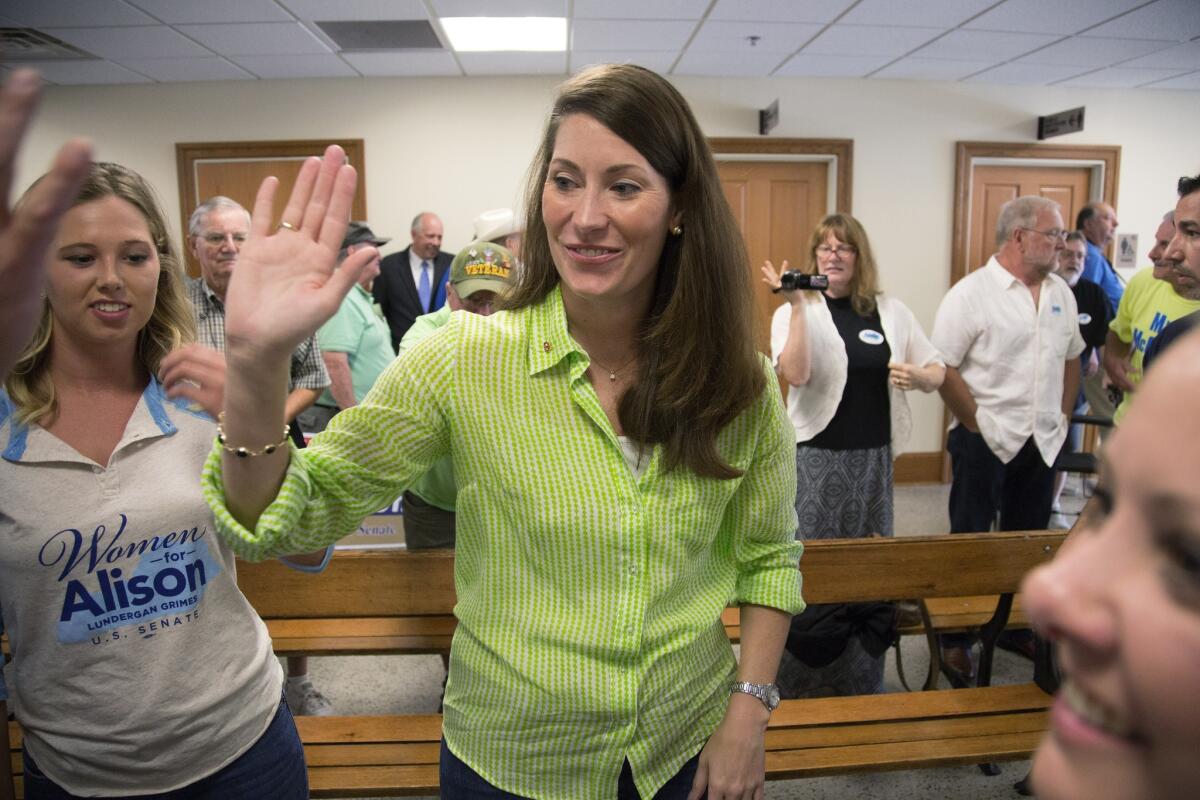As election nears, control of Senate looks surprisingly uncertain

Just over a month before the midterm election, control of the U.S. Senate remains surprisingly up for grabs as Democrats parlay a financial edge and other advantages to battle history and a strong anti-Obama tide.
Republicans still enjoy the more secure position. The GOP is almost certain to win open-seat contests in Montana, South Dakota and West Virginia, getting them halfway to the six seats needed to win a majority and gain control.
But the party’s candidates have yet to put away any of the 10 or so most competitive Senate races, buoying Democratic hopes they can hang on to at least one chamber of Congress despite what appeared, at the start of this election year, to be long odds.
In Louisiana, Arkansas and Alaska, where President Obama’s approval ratings are particularly low, Democratic incumbents have kept their uphill races within striking distance. It helps that the candidates — Mary L. Landrieu, Mark Pryor and Mark Begich — come from prominent political families, making them familiar brand names in their respective states. But even in North Carolina, first-term Democratic Sen. Kay Hagan, a prime Republican target, has clung to a small but consistent lead in recent voter surveys.
Part of the reason is money. Democrats, unexpectedly, have had more of it this year than Republicans. And part of it is mechanics — allocating resources, targeting voters, getting them to the polls — which national Democrats have excelled at over the last decade.
In that time, Democrats have defeated 12 sitting Republican senators. Republicans have ousted just three Democratic incumbents, two of them in the last midterm election under Obama, in 2010.
Historically, the midterm vote has been a referendum on the president, and this one appears to be no exception. There are three typical outcomes for the party in the White House, said Charlie Cook, a longtime nonpartisan campaign analyst: “Bad; really bad; and really, really bad.”
To a great extent Democrats are simply fighting for the least bad result, which would be clinging to the Senate by the narrowest of margins. (Republicans are expected to modestly pad their majority in the House and could lose a handful of governor’s seats.)
The GOP started the year with a distinct advantage in the Senate fight. Democrats have been forced to defend far more seats, thanks to their gains when Obama was elected in 2008, and a number of retirements in conservative-leaning states. Of the most competitive races, all but a handful are in places that Obama lost in 2012, several by landslide margins.
Also working in favor of Republicans are the election’s broad themes — the appropriate size and scope of government, Obama’s leadership and competence — which match those of 2010, a banner year for the GOP.
Democrats have tried to shift the focus from a debate over big government, embodied by the unpopular national healthcare law, to the merits of popular programs, such as Social Security and Medicare, and issues that are especially resonant to minorities, young people and single women. All are Democratic-leaning voter groups that tend to sit out midterm elections.
“Our candidates are asking theirs, ‘Where are you on minimum wage? Where are you on equal pay [for women]? Where are you on college tuition?’” said Sen. Charles E. Schumer of New York, one of the Democratic Party’s top political strategists.
That tactic — one party trying to nationalize the election, the other trying to make contests more localized and issue-specific — is also typical of midterm elections.
Another time-honored tradition is candidates distancing themselves from the unpopular president of their own party; some Democrats this year have gone so far as to criticize Obama in their TV advertising.
“I disagree with him on guns, coal” and the Environmental Protection Agency, says a skeet-shooting Alison Lundergan Grimes, Kentucky’s Democratic secretary of state, who faces Senate Minority Leader Mitch McConnell in a fiercely fought contest.
Begich, locked in a tough race with former GOP Atty. Gen. Dan Sullivan, cited several differences with Obama in a recent TV spot, over taxes, the environment and defense spending. “True Alaska,” read the logo opening Begich’s advertisement.
What is notable this year is Democrats’ considerable financial advantage, which will not necessarily determine control of the Senate but, at the least, has kept many contests close heading into the final five weeks of the campaign.
The Democrats’ Senate campaign committee raised $111 million through August, nearly $30 million more than the Republican committee, and outside groups have enhanced the party’s cash lead. In the 10 most competitive Senate races, pro-Democratic forces have outspent their Republican counterparts $80 million to $73 million through Friday, according to data from the Center for Responsive Politics, an organization that tracks campaign spending.
Crucially, the Democrats have used their money edge to reserve far more TV air time than Republicans in the campaign’s final stretch, meaning even if the GOP and its allies catch up financially they will have to pay much higher last-minute rates.
Writing in the Wall Street Journal this month, Republican strategist Karl Rove lamented the financial disparity in a commentary that amounted to a thinly veiled plea for donors to open their checkbooks.
“The midterm environment is terrible for Democrats,” Rove wrote, “yet each passing day provides evidence as to why a GOP Senate majority is still in doubt.” (Many Republican donors have sat on their wallets out of frustration with a Rove-affiliated “super PAC” and other groups that collected tens of millions of dollars in 2012 and failed to elect Mitt Romney president or deliver a Republican Senate.)
Scott Reed, a Republican strategist for the U.S. Chamber of Commerce, remains sanguine. “The sand continues to feel like it’s shifting our way,” he said, though he also sounded a cautionary note: “Experience shows it’s not easy defeating incumbent Democratic U.S. senators.”
Whatever happens Nov. 4, it is likely that today’s toss-up races will break decisively in favor of one party.
“It doesn’t have to be a wave, or even a strong wind,” said Cook, the independent campaign analyst. “Just a whiff can make races that are fundamentally tied fall almost entirely in the same direction.”
Even then control of the Senate may not be decided. Under their election rules, the contests in Louisiana and Georgia could push into December and January, respectively, if no candidate wins more than 50% in November.
Twitter: @markzbarabak
@lisamascaroindc
More to Read
Get the L.A. Times Politics newsletter
Deeply reported insights into legislation, politics and policy from Sacramento, Washington and beyond. In your inbox three times per week.
You may occasionally receive promotional content from the Los Angeles Times.












